BAME communities and the impact of the coronavirus

In a guest blog from the Immigration Advice Service, Harry Sanders highlights the disproportionate effect of Covid-19 on BAME communities, a reality which has become a concern, as well as a call to action, for many of us working within a diverse faith sector.
Over the past months, COVID-19 has brought the UK to a standstill and, in the process, taken countless thousands of lives. Many have been unable to say goodbye to their loved ones or even to hold funerals for them, and despite the gradual slowing of the virus’ spread, the nation is still very much in the grip of the destruction it has caused.
Now, with the added data from the last three months, trends in the spread of the virus are able to be seen in sharper detail. One of the key findings brought by these statistics is that BAME communities have been much harder hit than their white neighbours. According to research by ICNARC, although BAME groups make up just 13% of the UK’s population, they account for 35% of all COVID-19 patients admitted to critical care units. Similarly, a staggering 95% of medical staff deaths have been BAME NHS workers, who comparatively only account for 45% of all medical staff. There is clearly a correlation between having a BAME background and contracting coronavirus, and there are several possible causes for these figures.
The demographic spread of BAME individuals is one possible contributing factor for the higher death rate amongst BAME communities. This correlation should not be immediately clear, as most ethnic minority groups are, on average, younger than the white British majority’s 25% of individuals over the age of 60, and it is believed that the virus attacks older patients more aggressively. Despite this, it is important to note that BAME communities in the UK are a lot more urbanised than their white British counterparts – for instance, London is home to 60% of the country’s overall black population, and to 50% of it’s Bangladeshi population, while only 8% of the nation’s white British majority live in the city. Geography and demographics clearly have some influence on the mortality rate of BAME individuals, with London accounting for roughly 20% of confirmed cases between both England and Wales. This cannot be the whole story, however, as white Londoners have not been affected equally as adversely by the virus as urban BAME communities.
Looking past simple demographic differences, it becomes apparent that there are myriad other factors which may influence the higher risk to minority individuals. Lifestyle factors, genetic predisposition or physiological differences can all play a key role in exacerbating the spread of any disease – though this is especially so for highly contagious respiratory viruses such as COVID-19, and factors such as these can contribute to increased disease severity in COVID-19.
Many such circumstances which can lead to an increased risk of infection, however, are influenced by socioeconomic factors. In London, for instance, just under a fifth of Bangladeshi, Indian and Pakistani households are inhabited by a single person (11%, 17%, and 13%, respectively). Minority households are also more likely to be overcrowded, which inhibits residents’ abilities to properly self-isolate – before any symptoms are noticed, transmission is essentially guaranteed. That being said, this may not be the key root of the higher BAME mortality rate, as black Caribbeans – the minority group with the highest number of hospital deaths per capita – face considerably less overcrowding than the other groups mentioned. It is difficult to pinpoint the exact nature of the relationship between socioeconomic situation and infection rate, but when contrasted with white majority cases, it is clear that BAME communities are at an increased risk of contracting coronavirus, due to their socioeconomic status and living conditions.
One final and highly important statistic that must be questioned is the disproportionately high rate of deaths in high-risk BAME workers. As aforementioned, 95% of medical staff deaths in the NHS were of BAME workers, though this phenomenon appears in more than just our hospitals. The BAME staff in the care sector have been similarly hit by the coronavirus, with half of all health and social care workers to have died from the disease having been born outside the UK. While data is currently lacking, it is unsurprising that those caring for the most unwell patients – and similarly those who are most likely to need to undergo aerosol generating procedures (AGPs) such as chest compressions or tracheotomies – are at the highest risk of transmission and infection. As with socioeconomic pressures, the specific influences leading to this higher transmission rate are not abundantly clear, though with similar numbers of BAME health workers now succumbing to COVID-19 in the United States, it is clear that such a correlation exists.
Despite battling coronavirus for several months, it seems still that little is being done to prevent the much higher mortality rate found in BAME communities. At a time when the inequality faced by many of our minority communities has never seemed so prominent, decisive action must be taken to ensure that all are equally protected from this global pandemic.


